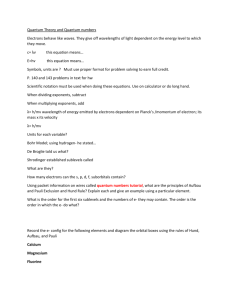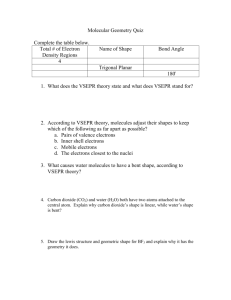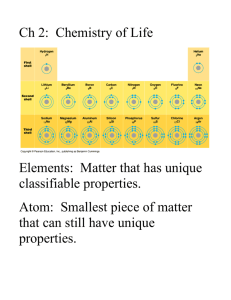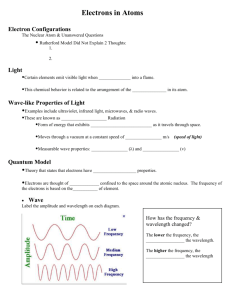MCAT Chemistry Equation Sheet: Key Formulas & Concepts
advertisement
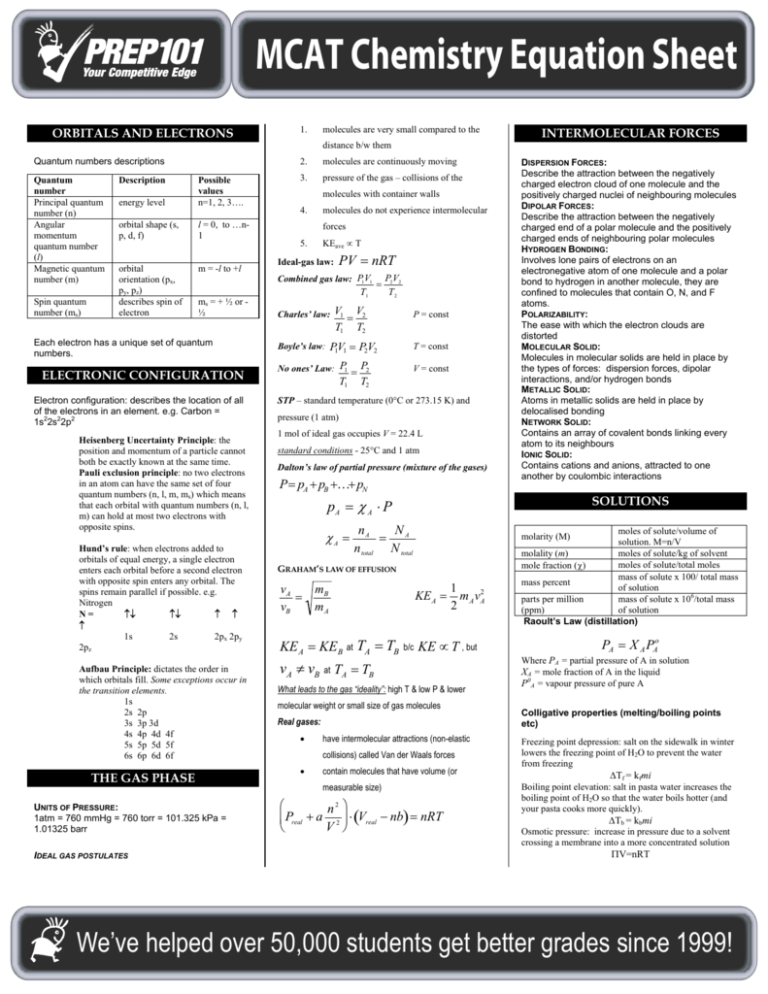
MCAT Chemistry Equation Sheet ORBITALS AND ELECTRONS 1. molecules are very small compared to the INTERMOLECULAR FORCES distance b/w them Quantum numbers descriptions Quantum number Principal quantum number (n) Angular momentum quantum number (l) Magnetic quantum number (m) Spin quantum number (ms) Description energy level Possible values n=1, 2, 3…. orbital shape (s, p, d, f) l = 0, to …n1 orbital orientation (px, py, pz) describes spin of electron m = -l to +l molecules are continuously moving 3. pressure of the gas – collisions of the molecules with container walls 4. molecules do not experience intermolecular forces KEave ∝ T 5. Ideal-gas law: PV = nRT Combined gas law: P1V1 ms = + ½ or ½ Each electron has a unique set of quantum numbers. ELECTRONIC CONFIGURATION Electron configuration: describes the location of all of the electrons in an element. e.g. Carbon = 1s22s22p2 Heisenberg Uncertainty Principle: the position and momentum of a particle cannot both be exactly known at the same time. Pauli exclusion principle: no two electrons in an atom can have the same set of four quantum numbers (n, l, m, ms) which means that each orbital with quantum numbers (n, l, m) can hold at most two electrons with opposite spins. Hund’s rule: when electrons added to orbitals of equal energy, a single electron enters each orbital before a second electron with opposite spin enters any orbital. The spins remain parallel if possible. e.g. Nitrogen N= ↑↓ ↑↓ ↑ ↑ ↑ 1s 2s 2px 2py 2pz Aufbau Principle: dictates the order in which orbitals fill. Some exceptions occur in the transition elements. 1s 2s 2p 3s 3p 3d 4s 4p 4d 4f 5s 5p 5d 5f 6s 6p 6d 6f THE GAS PHASE UNITS OF PRESSURE: 1atm = 760 mmHg = 760 torr = 101.325 kPa = 1.01325 barr IDEAL GAS POSTULATES 2. T1 Charles’ law: = P2V2 T2 V1 V2 = T1 T2 P = const P1V1 = P2V2 Boyle’s law: T = const No ones’ Law: P1 = P2 T1 V = const T2 STP – standard temperature (0°C or 273.15 K) and pressure (1 atm) 1 mol of ideal gas occupies V = 22.4 L standard conditions - 25°C and 1 atm Dalton’s law of partial pressure (mixture of the gases) P= pA + pB +K+ pN DISPERSION FORCES: Describe the attraction between the negatively charged electron cloud of one molecule and the positively charged nuclei of neighbouring molecules DIPOLAR FORCES: Describe the attraction between the negatively charged end of a polar molecule and the positively charged ends of neighbouring polar molecules HYDROGEN BONDING: Involves lone pairs of electrons on an electronegative atom of one molecule and a polar bond to hydrogen in another molecule, they are confined to molecules that contain O, N, and F atoms. POLARIZABILITY: The ease with which the electron clouds are distorted MOLECULAR SOLID: Molecules in molecular solids are held in place by the types of forces: dispersion forces, dipolar interactions, and/or hydrogen bonds METALLIC SOLID: Atoms in metallic solids are held in place by delocalised bonding NETWORK SOLID: Contains an array of covalent bonds linking every atom to its neighbours IONIC SOLID: Contains cations and anions, attracted to one another by coulombic interactions SOLUTIONS pA = χ A ⋅ P χA = nA N = A n total N total GRAHAM’S LAW OF EFFUSION vA = vB mB mA KE A = KEB at TA = TB KE A = b/c 1 m A vA2 2 KE ∝ T , but vA ≠ vB at TA = TB What leads to the gas “ideality”: high T & low P & lower molecular weight or small size of gas molecules Real gases: • have intermolecular attractions (non-elastic collisions) called Van der Waals forces • moles of solute/volume of solution. M=n/V molality (m) moles of solute/kg of solvent moles of solute/total moles mole fraction (χ) mass of solute x 100/ total mass mass percent of solution parts per million mass of solute x 106/total mass (ppm) of solution Raoult’s Law (distillation) molarity (M) contain molecules that have volume (or measurable size) ⎛ n2 ⎞ P + a ⎜ real ⎟ ⋅ (Vreal − nb) = nRT V2⎠ ⎝ PA = X A PAo Where PA = partial pressure of A in solution XA = mole fraction of A in the liquid P0A = vapour pressure of pure A Colligative properties (melting/boiling points etc) Freezing point depression: salt on the sidewalk in winter lowers the freezing point of H2O to prevent the water from freezing ∆Tf = kfmi Boiling point elevation: salt in pasta water increases the boiling point of H2O so that the water boils hotter (and your pasta cooks more quickly). ∆Tb = kbmi Osmotic pressure: increase in pressure due to a solvent crossing a membrane into a more concentrated solution ΠV=nRT We’ve helped over 50,000 students get better grades since 1999! Need help for exams? Check out our classroom prep sessions - customized to your exact course - at www.prep101.com ACID-BASE EQUILIBRIA ARRHENIUS ACID: Anything that produces hydrogen ions in aqueous solution Arrhenius Base: Anything that produces hydroxide ions in aqueous solution BRØNSTED-LOWRY ACID: A species that donates a proton is an acid BRØNSTED-LOWRY BASE: A species that accepts a proton is a base Amphiprotic Species: a chemical species that can both donate and accept protons Lewis Acid: Anything that accepts a pair of electrons Lewis Base: Anything that donates a pair of electrons WATER EQUILIBRIUM CONSTANT (KW): Kw = [H3O+][OH−] = 1.00×10−14 (at 298 K) STRONG ACIDS: Acids that donate protons to water molecules quantitatively Strong Base: A substance that generates hydroxide ions quantitatively in aqueous solution. PH SCALES: pH = −log[H3O+] pOH = −log[OH−] pKa = −log Ka pKb = −log Kb pH + pOH = 14.00 KaKb = Kw pKa+ pKb = 14.00 WEAK ACID: Acid that reaches equilibrium when only a small fraction of its molecules transfer protons to water WEAK BASE: Generates hydroxide ions by accepting protons from water but reaches equilibrium when only a fraction of its molecules have done so APPLICATIONS OF AQUEOUS EQUILIBRIA: BUFFER SOLUTION: Contains both a weak acid and its conjugate base as major species in solution, [ ] ⎛ A− initial ⎞ ⎟⎟ pH = pK a + log⎜⎜ ⎝ [HA]initial ⎠ BUFFER CAPACITY: The amount of added H3O+ or OH− the buffer solution can tolerate without exceeding a specified pH range. CHEMICAL KINETICS REACTION MECHANISM: The exact molecular pathway that starting materials follow on their way to becoming products RATE-DETERMINING STEP: The slowest elementary step in a mechanism FIRST-ORDER RATE LAW: Rate = k[A], where A is a reactant in the overall reaction, this can be converted to ⎛ [A]0 ln⎜⎜ ⎝ [A] ⎞ ⎟⎟ = kt ⎠ HALF-LIFE (T1/2), 1ST ORDER: When half the original concentration has been consumed, [A] = 0.5[A]0, t1 / 2 = ln 2 k SECOND-ORDER RATE EXPRESSION: Rate = k[A]2, this can be converted to 1 1 − = kt [A] [A]0 BIMOLECULAR ELEMENTARY REACTION: A + B → products Elementary rate = k[A][B] UNIMOLECULAR ELEMENTARY REACTION: C → products Elementary rate = k[C] FIRST STEP IS RATE-DETERMINING: The predicted rate law for the overall reaction is the rate expression for that first step ACTIVATION ENERGY (EA): Energy barrier, the minimum energy that must be supplied before the reaction can occur Activated Complex: the molecular arrangement at the point of highest energy along the energy level diagram www.prep101.com CHEMICAL EQUILIBRIUM EQUILIBRIUM CONSTANT: K eq = d e [D]eq [E ]eq a [A ]eq [B]beq Keq applied only at equilibrium, Keq is independent of initial conditions, Keq is related to the stoichiometry. PURE LIQUID AND SOLID: The concentrations of pure liquids or solids are always equal to their standard concentrations, therefore division by standard concentration results in a value of 1 LARGE KEQ: Indicates that the reaction goes virtually to completion LE CHÂTELIER’S PRINCIPLE: When a change is imposed on a system at equilibrium, the system will react in the direction that reduces the amount of change. TEMPERATURE: The only variable that causes a change in the value of Keq, an increase in temperature always shifts the equilibrium position in the endothermic direction. THERMODYNAMICS CLOSED SYSTEM: Exchanges energy but not matter with its surroundings ISOLATED SYSTEM: Exchanges neither matter nor energy with the surroundings STATE VARIABLES: Conditions that must be specified to establish the state of a system, pressure (P), volume (V), temperature (T), and amounts of substances (n) PHYSICAL CHANGE OF STATE: Some of the state variables changes, but the chemical composition of the system stays the same CHEMICAL CHANGE OF STATE: The amounts of reactants and products change Chemical Reaction: some bonds break, and new bonds form STATE FUNCTION: A property that depends only on the state of the system PATH FUNCTION: A property that depends on how a change takes place Molar Heat Capacity: The amount of heat needed to raise the temperature of 1 mol of substance by 1 Kelvin (1K) WORK (W): Energy used to move an object against an opposing force, w= Fd FIRST LAW OF THERMODYNAMICS: ∆Esys = qsys + wsys Exothermic Process: If the chemicals release heat, this heat gain raises the temperature of the surroundings ENDOTHERMIC PROCESS: If the chemicals absorb heat, this heat loss lowers the temperature of the surroundings qcalorimeter = Ccal∆T, q = nC∆T ENTHALPY: A thermodynamic quantity whose change equals the heat flow at constant pressure, ∆H = ∆E + ∆(PV) STANDARD ENTHALPY OF FORMATION ∆H fo : Enthalpy change accompanying the formation of one mole of a chemical substance from pure elements in their most stable forms under standard conditions HESS’ LAW: The enthalpy change for any overall process is equal to the sum of enthalpy changes for any set of steps that leads from the reactants to the products MOLAR HEAT OF SOLUTION: Measures net energy flow that occurs as substance dissolves MOLAR HEAT OF VAPORIZATION: The heat needed to vaporize one mole of a substance at its normal boiling point MOLAR HEAT OF FUSION: Heat needed to melt one mole of a substance at its normal melting point SUBLIMATION: A phase change in which a solid converts directly to a vapour without passing through the liquid phase, ∆Evap = ∆Hvap − RTvap SECOND LAW OF THERMODYNAMICS: Any spontaneous process increases the disorder of the universe ENTROPY: The state function that provides a quantitative measure of disorder and is symbolized S, q ∆S = T T Entropy Change of the Universe: Total entropy change, ∆Suniverse = ∆Ssystem + ∆Ssurroundings REACTION ENTROPIES: o ∆ S reaction = ∑ coeff p ∆ S o − ∑ coeff r ∆ S o Our Course Booklets - free at prep sessions - are the “Perfect Study Guides.” Need help for exams? Check out our classroom prep sessions - customized to your exact course - at www.prep101.com REACTION ENTHALPIES: o ∆ H reaction = ∑ coeff p ∆ H fo − ∑ coeff r ∆ H fo Free Energy (G): A state function whose change for the system predicts spontaneity and is defined by, Free energy G = H − TS CHANGE IN FREE ENERGY: ∆Gsys = ∆Hsys − T∆Ssys ∆Gsys is negative for all spontaneous processes under conditions of constant temperature and pressure. STANDARD MOLAR FREE ENERGY OF FORMATION ∆Gfo : The change of free energy when one mole of that substance is formed from elements in their standard states, ∆G o reaction = ∑ coeff p ∆G − ∑ coeff r ∆G o f o f ENTROPY CHANGE NON-STANDARD CONDITIONS: Concentrations can be expressed in terms of the standard entropy change and Q: o ∆ S reaction = ∆ S reaction − R ln Q ∆ G reaction = ∆ G o reaction + − + − ∆G˚high T − + − + Reduction – gain of electrons by a substance and a decrease in oxidation state Reducing agent – a species that loses electrons and is oxidized www.prep101.com Oxidizing agent – a species that gains electrons and is reduced Anode – electrode where oxidation occurs, half-reaction with the more negative reduction potential occurs at the anode Cathode – electrode where reduction occurs, half-reaction with the more positive reduction potential occurs at the cathode Cell potential: o o o Ecell = Ecathode − Eanode Gibbs free energy and E − R Tln Q ∆G = −nFE ∆ G To = ∆ H ∆S˚ Oxidation – loss of electrons from a substance and an increase in oxidation state , ∆H˚ low T − + + − o o cell : o cell Relationship between Ecell and Keq: INFLUENCE OF TEMPERATURE ON SPONTANEITY: ∆H ˚ − + + − ELECTROCHEMISTRY − T∆S ° E cell = o Spontaneit y All T No T High T Low T RT ln K eq nF Ecell as a function of concentrations E cell = E ° cell − RT ln Q nF Electrolytic cell – uses electricity to produce an non-spontaneous reaction Phase Diagram for Water 1 mol e − ⎛C⎞ number of mol e − = current⎜ ⎟ × time(s) × 96,485C ⎝s⎠ Pressur e For water Negative slope for solid-liquid boundary liquid Supercritical fluid (high density & low viscosity) melting crystallization Critical point soli d 1 atm vaporization condensation Triple point sublimation deposition ga T Tb Temperature Our Course Booklets - free at prep sessions - are the “Perfect Study Guides.”

